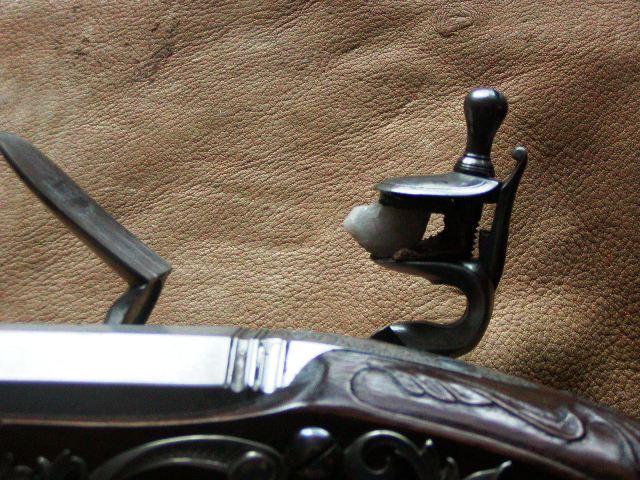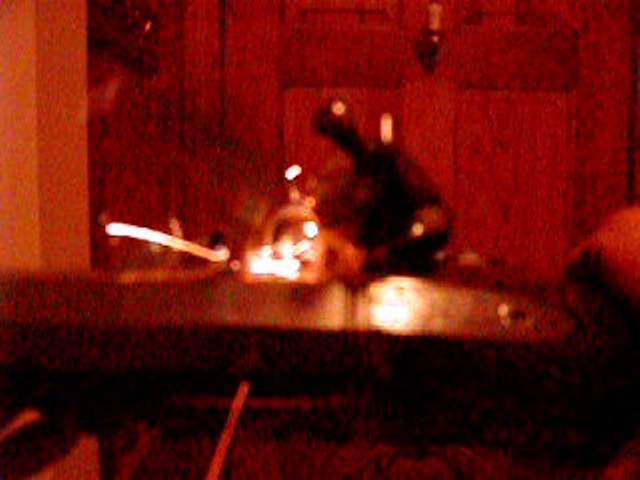hanshi
Cannon
Over all I've found the black, white and amber flints to be just about equal at making sparks.

This comes from a guy that used to knap chert flints here is the US. He's retired now. I wish I had bought a few. My loss. I tried knapping, and haven't mastered it yet.. Either they a paper thin, or look like hump back whales. Not to mention too narrow, or too wide. Yes, it's a skill.Flint knapping is a skill. Plus there are quarries with hundreds or thousands of tons of high quality flint in England and France. Economy of scale.
May I suggest looking up indirect percussion and how it is done. It has helped me immensly in point and gun flint knapping. Pressure flaking is also immeasurably helpful in finishing out edges for both applications. The tools are easily made by ones self or they can be purchased commercially.This comes from a guy that used to knap chert flints here is the US. He's retired now. I wish I had bought a few. My loss. I tried knapping, and haven't mastered it yet.. Either they a paper thin, or look like hump back whales. Not to mention too narrow, or too wide. Yes, it's a skill.


I love it…that is such an awesome demo….Hi,
Here is a dull piece of quartz in a Chambers round-faced English lock.


It speaks more to how well the lock was designed, made, and tuned rather than any sparking qualities of quartz. Any mineral or rock that scratches hardened steel should produce sparks but flint, agate, and chert have the right balance of workability to shape them, hardness, and ductility to resist shattering. In Erhard Wolf's book on German jaeger rifles is a nice section on flints, flint mining, and making based on 18th and early 19th century sources. Flints were mined in pits or caves and extracted from seams containing flint nodules. Because the silica absorbs water, flints will dry out if exposed to dry and warm air for a long time. When they dry out, they become much more brittle. Flint makers wanted hydrous flint nodules extracted from caves or mine shafts and they stored the nodules in barrels in damp basements until ready for knapping. The knapped flints were then stored in barrels again in a damp location away from sunlight and direct heat. Professional flint knappers did not waste time on any nodules found above ground because there was too much waste getting to the cores of the nodules that still had hydrous flint. According to the sources, flints from the Cher River region of central France were the most highly valued.
dave
Hi,
Here is a dull piece of quartz in a Chambers round-faced English lock.


It speaks more to how well the lock was designed, made, and tuned rather than any sparking qualities of quartz. Any mineral or rock that scratches hardened steel should produce sparks but flint, agate, and chert have the right balance of workability to shape them, hardness, and ductility to resist shattering. In Erhard Wolf's book on German jaeger rifles is a nice section on flints, flint mining, and making based on 18th and early 19th century sources. Flints were mined in pits or caves and extracted from seams containing flint nodules. Because the silica absorbs water, flints will dry out if exposed to dry and warm air for a long time. When they dry out, they become much more brittle. Flint makers wanted hydrous flint nodules extracted from caves or mine shafts and they stored the nodules in barrels in damp basements until ready for knapping. The knapped flints were then stored in barrels again in a damp location away from sunlight and direct heat. Professional flint knappers did not waste time on any nodules found above ground because there was too much waste getting to the cores of the nodules that still had hydrous flint. According to the sources, flints from the Cher River region of central France were the most highly valued.
dave
We have tons of Jasper in Oregone, time for me to stock up. Thanks for the tip.Jasper
Lots of Quartz in Oregone too. I hear we have Chert here too, I'll have to check it out. Also have Obsidian here, but I'm not sure if that would work or not ? Does anyone know ?Quartz, and/or groove your steel face and you can be a little more free with your stone choices (doesn't have to be all that sharp either, some stones are hard enough to get sparks off a grooved steel-face, but won't hold up if sharpened to much more than a round point). clicking on the pic will take you to the auction site this was on for a better look. This is one of my favorite pieces to look at, and inspired some of my personal aesthetic ideas.
View attachment 134391
I believe there are "Herkimer Diamonds" in the Desert's of So. Cal, not sure if those would work ?So is it the harder the substance you us for a flint the better? If so wouldn't a diamond be the best? No that anyone would have such a diamond laying around but if they did would it work?
Opal is volcanic so probably but priceyI wonder if opal will strike sparks? How cool would that look on your cock?
Never heard of them but I'll definitely check it out.I believe there are "Herkimer Diamonds" in the Desert's of So. Cal, not sure if those would work ?